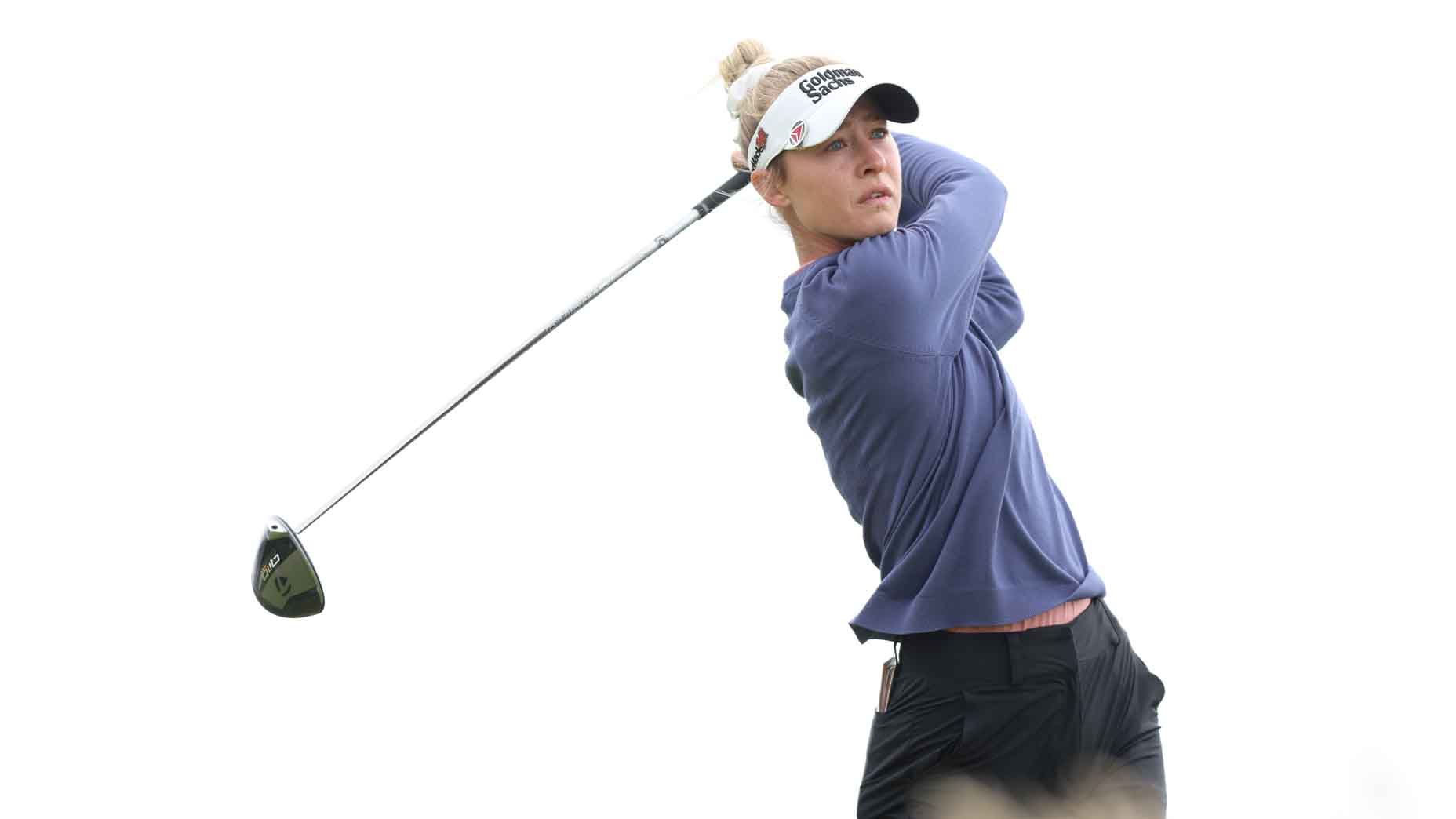Nelly Korda’s 17-month run as World No. 1 — her sixth time atop the Rolex Rankings — ended Monday when Thailand’s Jeeno Thitikul officially eclipsed the American.
Korda’s fall from No. 1 comes one day after she finished T36 at the AIG Women’s Open at Royal Porthcawl, capping a major championship season in which she failed to be a weekend factor in four of the five tournaments. After winning seven times during a blistering 2024 campaign, Korda has yet to win this season. The LPGA has had 21 different winners in 20 events, but Korda has not yet lifted a trophy.
Korda’s drop to No. 2 will naturally lead to big-picture questions and thoughts about her season and what it says about the state of women’s golf and her place atop the sport. In a society prone to hyperbole, it would be easy to claim that Korda’s winless season (so far) and fall from World No. 1 is an indictment of her talent or ability to be the wind in women’s golf’s sails.
But if you zoom out and take stock of both of Korda’s past two seasons and the nature of golf, the answer is much simpler.
Nelly Korda’s season
The first thing to note is that statistically, Nelly Korda is not playing worse golf than she did a season ago. Numbers can be deceiving, but last year, when she won seven times, Korda’s stats were as follows:
Strokes Gained: Total (LPGA Rank): 2.84 (1)
Strokes Gained: Tee to Green: 1.88 (3)
Strokes Gained: Off the Tee: 0.87 (2)
Strokes Gained: Approach: 0.59 (22)
Strokes Gained: Around the Green: 0.42 (4)
Strokes Gained: Putting: 0.41 (34)
Birdie Percentage: 24.37 (2)
Birdie or Better Percentage: 25.12 (2)
Bogey Avoidance: 13.06 % (5)
Those numbers so far this season? They aren’t far off, and, per KPMG Performance Insights, Korda actually has better strokes gained total and strokes gained putting averages than she did at this point last season. Here are the numbers overall this season to this point:
Strokes Gained: Total: 2.43 (3)
Strokes Gained: Tee to Green: 1.67 (4)
Strokes Gained: Off the Tee: 1.04 (1)
Strokes Gained: Approach: 0.65 (16)
Strokes Gained: Around the Green: -0.02 (81)
Strokes Gained: Putting: 0.80 (17)
Biride Percentage: 25.41 (1)
Birdie or Better Percentage: 25.77 (1)
Bogey Avoidance: 14.89 percent (23)
So, what do we make of a season that looks similar statistically but has seven fewer wins and has seen Korda drop to World No. 2? First of all, it’s hard to win in golf. You need a lot of things to go your way, some of which are out of your control.
In the first tournament of the season, the Hilton Grand Vacations Tournament of Champions, Korda went on a Sunday charge that saw her make nine birdies while shooting a seven-under 65 as she tried to hunt down A Lim Kim. That would have been enough to win a lot of tournaments, but Kim carded three birdies in her final four holes to hold off Nelly and win by two.
Sometimes you just get beat.
The same can be said for this year’s U.S. Women’s Open, where Korda was the best player tee-to-green at Erin Hills but was plagued by a cold putter that lost 0.42 strokes during the week. Korda led the field that week in strokes gained off the tee (1.82) and picked up over a shot on approach shots (1.18), but couldn’t overtake winner Maja Stark on Sunday when her putter went cold. Korda’s heartbreak at Erin Hills was eerily similar to Rory McIlroy’s loss at the 2023 U.S. Open, where he couldn’t get anything to fall on Sunday and one bad swing was the difference in a one-shot loss to Wyndham Clark.
The flipside of this coin is that since Korda’s T2 at Erin Hills, she has just one top-10 finish, which was a fifth place at the ISPS HANDA Scottish Open. She finished T19 at the KPMG Women’s PGA Championship at PGA Frisco, recorded a T43 at the Evian, and a T36 this past week at Royal Porthcawl. Add in the T14 at the Chevron, where Korda took herself out of contention with an opening-round 77, and that’s four out of five majors in which the 27-year-old was not a factor on the weekend.
Last year, Korda won the Chevron and finished T2 at the AIG Women’s Open, where a brutal back nine doomed her chances. While she missed the cut at the U.S. Women’s Open and KPMG Women’s PGA, Korda only had four other tournaments all season where she finished outside the top 10. She has finished outside the top 10 eight times this season in 13 starts.
“It’s been a very interesting year for me,” Korda said at Erin Hills. “Definitely have had a bit of good and a bit of bad. Kind of a mix in kind of every event that I’ve played in. I would say just patience is what I’ve learned, and kind of going back home and really locking in and practicing hard.
“It’s golf,” she said at PGA Frisco ahead of the KPMG Women’s PGA Championship. “Every year is just so different. Last year, coming into this event, I had five wins. I think even Hannah Green had multiple wins under her belt, too, coming into this event. It’s just golf. You kind of just have to ride the wave, and the competition is getting better and better every year.”
Korda set an impossibly high bar for herself last season. Winning seven times is an outlier. Her play this season, while still good statistically, has been below that bar and even a tick below what should be expected of her on a yearly basis. Should she go winless this season, that too would be an outlier.
What to make of Korda’s season
My colleague James Colgan had a great pull in our Tour Confidential roundtable, recalling what Augusta National chairman Fred Ridley said when asked about Caitlin Clark’s impact on women’s basketball and why the same wasn’t happening for women’s golf as Korda was winning five tournaments in a row.
“We hope that more people will come along like (Clark), and certainly we hope that people will come along in golf,” Ridley said, who then went on to riff about the Augusta National Women’s Amateur before returning to his point about Clark. “But I just think it’s kind of a unicorn, really, we need more unicorns in that regard.”
Ridley’s comments were not particularly well received as Korda burned down every course she stepped on. But his point was that, be it Korda or not, women’s golf needs a transformational star to elevate it to the next level. It needs a superstar to pull in eyeballs.
Perhaps Korda can still be that. Maybe she’s just a star, but not the “unicorn” the game needs. Regardless, a dip in 2025 and a fall to No. 2 will not deliver a verdict on that question. It’s nothing more than the ebb and flow of golf. We’ve seen it countless times from great players before. In 2017, Rory McIlroy, who had won seven times in two years, went winless and plummeted to 11th in the world. After the season, the Northern Irish star said he played through a nagging rib issue, but he still finished T7 at the Masters and T4 at the Open, so his game was good enough to compete. Likewise, between November 2019 and May 2021, McIlroy went 25 events without a win as he fell to ninth in the world. He quickly rose back to World No. 1 and has won 11 times worldwide since 2022. Each small dip spurred McIlroy’s game to greater heights as he worked to become a “more complete player.” The results followed.
There’s every reason to believe the same will be true of Korda. Whether or not that ink bleeds into the bigger picture, women’s golf is trying to color in remains to be seen.

Josh Schrock
Josh Schrock is a writer and reporter for Golf.com. Before joining GOLF, Josh was the Chicago Bears insider for NBC Sports Chicago. He previously covered the 49ers and Warriors for NBC Sports Bay Area. A native Oregonian and UO alum, Josh spends his free time hiking with his wife and dog, thinking of how the Ducks will break his heart again, and trying to become semi-proficient at chipping. A true romantic for golf, Josh will never stop trying to break 90 and never lose faith that Rory McIlroy’s major drought will end (updated: he did it). Josh Schrock can be reached at josh.schrock@golf.com.







